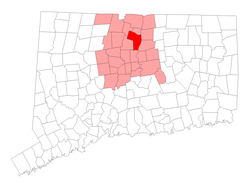Windsor, Connecticut
| Windsor, Connecticut | ||
|---|---|---|
| Town | ||
|
||
| Motto: First in Connecticut, First for its Citizens | ||
 Location in Hartford County, Connecticut |
||
| Coordinates: 41°51′10″N 72°38′35″W / 41.85278°N 72.64306°WCoordinates: 41°51′10″N 72°38′35″W / 41.85278°N 72.64306°W | ||
| NECTA | Hartford-West Hartford-East Hartford | |
| Region | Capitol Region | |
| Settled | September 26, 1633 | |
| Named | 1637 | |
| Government | ||
| • Type | Council-manager | |
| • Town manager | Peter Souza | |
| • Town council | Donald S. Trinks (D), Mayor; Jody L. Terranova (D), Deputy Mayor; John J. Gamache (R); William H. Herzfeld (D); Donald A. Jepsen, Jr. (R); Kenny M. Wilkos (R); Randy McKenney (D); Alan J.Simon (D); Jim G. Govoni (R) |
|
| Area | ||
| • Total | 31.0 sq mi (80.2 km2) | |
| • Land | 29.5 sq mi (76.4 km2) | |
| • Water | 1.5 sq mi (3.8 km2) | |
| Elevation | 55 ft (17.37 m) | |
| Population (2010) | ||
| • Total | 29,044 | |
| • Density | 940/sq mi (360/km2) | |
| Time zone | Eastern (UTC-5) | |
| • Summer (DST) | Eastern (UTC-4) | |
| ZIP code | 06095 | |
| Area Code | 860 | |
| FIPS code | 09-87000 | |
| GNIS feature ID | 0212354 | |
| Website | www |
|
| Elevation noted at Town Hall. | ||
Windsor is a town in Hartford County, Connecticut, United States, and was the first English settlement in the state. It lies on the northern border of Connecticut's capital, Hartford. The population of Windsor was 29,044 at the 2010 census.
Poquonock is a northern area of Windsor that has its own zip code (06064) for post-office box purposes. Other unincorporated areas in Windsor include Rainbow and Hayden Station in the north, and Wilson and Deerfield in the south.
The Day Hill Road area is known as Windsor's Corporate Area, although other centers of business include New England Tradeport, Kennedy Industry Park and Kennedy Business Park, all near Bradley International Airport and the Addison Road Industrial Park.
The coastal areas and riverways were traditional areas of settlement by various cultures of indigenous peoples, who had been in the region for thousands of years. They relied on the rivers for fishing, water and transportation. Before European contact, the historic Pequot and Mohegan tribes had been one Algonquian-speaking people. After they separated, they became competitors and traditional enemies in the Connecticut region.
During the first part of the 17th century, the Pequot and Mohegan nations had been at war. The Podunk were forced to pay tribute to the more powerful Pequot, who claimed their land. Eventually, the Podunk invited a small party of settlers from Plymouth, Massachusetts, to settle as a mediating force between the other tribes. In exchange they granted them a plot of land at the confluence of the Farmington River and the west side of the Connecticut River. After Edward Winslow came from Plymouth to inspect the land, William Holmes led a small party, arriving at the site on September 26, 1633, where they founded a trading post.
...
Wikipedia

